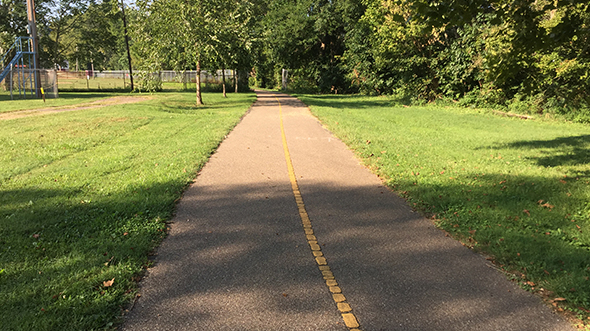
BLOG
—
Landscape Architecture: Strolling Through Resilient Design in Leisurely Spaces
You’re gazing at the Washington Monument on a cool spring evening, lights emblazoned, as you sit on The National Mall. Or maybe you’re jogging through the light morning fog along the terraced banks of Chicago’s Riverwalk park. But then again, you might be awakening to the frightening sound of a grizzly bear rummaging through the trash near your encampment in Yellowstone National Park.
These three scenarios evoke different feelings, and yet landscape architects (LA) played a role in designing each of these iconic environments. While resilience and sustainability are at the heart of the profession, there is no shortage of complications in that relationship.
First, let’s define rsilience in the context of landscape architecture. According to the American Society of Landscape Architects, resilient design means working with nature and allowing communities to bounce back stronger and more quickly than with previous “one-size-fits-all” approaches.
Resilient design includes well-known measures like man-made reefs, urban forests and green infrastructure, which controls flooding. Resilient design also entails using locally sourced materials, creating systems and places for people to connect with flora and fauna, and designing spaces that are easily adaptable as time, usage and the ephemeral qualities of a place shift.
Resilience in Landscape Architectural History
While the profession semi-officially took root in the late 1800s, designed spaces and gardens date back centuries. From the steps of the Parthenon to Japanese gardens to the expansive parterres at the Palace of Versailles, the work of LAs has touched souls around the world. Even in its earliest form, those designing our outdoor spaces took resilience and sustainability into consideration.
The Parthenon, built upon the Acropolis in the fifth century BC, was constructed of materials that were local to Athens, Greece. While site designers largely manipulated the city’s prominent hilltop, this sacred place remains special nearly 2,500 years later due to those designers’ use of local materials while creating spaces for worship, gathering and rest in the cool breezes coming in off the Saronic Gulf.
Japanese gardens, which often use non-native ornamental plantings, incorporate multiple resilient design elements. The common practice of harnessing stormwater adds beauty through features such as ponds and rain chains, as does the enduring use of stone paving and the inclusion of local bamboo for fences and structures. These early Japanese gardens were expertly crafted to imitate nature and share views of the world beyond their borders.
The Palace of Versailles claimed its spot atop the world of landscape architecture in the 17th century due in large part to thumbing its nose at nature. France’s King Louis XIV enlisted Andre Le Notre to transform areas of marsh, meadow and a rolling landscape into the intricate, tidy and largely symmetrical palace gardens. Le Notre, who was a member of the family that had been gardeners to the king since the 16th century, accomplished unprecedented feats of earth-moving and engineering, carefully selecting materials that would maintain a resilient and sustainable environment for the king and his guests. For centuries, the gardens at the Palace of Versailles have provided vistas and meeting spaces for many to enjoy, featuring planted meadows and stormwater management practices that harness the power of rain catchment and gravity to fill canals and power fountains.
However, the official birth of landscape architecture is widely recognized as taking place in the late 19th and 20th centuries, when urban pocket parks like Keller Fountain Park in Portland, Ore.; the ecologically minded Emerald Necklace of Boston; and the quintessential “natural” respite that is New York City’s Central Park revolutionized the industry.
Lawrence Halprin, the LA for Keller Fountain Park, was one of the preeminent 20th-century modernist designers. Keller Fountain Park embodies the allure of resilient design by employing a healthy dose of fresh water and locally based stone and concrete, while its plaza serves as a prominent gathering place in Downtown Portland.
The Emerald Necklace was designed by the so-called “Father of Landscape Architecture,” Frederick Law Olmsted. The Necklace is a brilliant masterpiece of linked parks, trails and riverwalks that stretches from the Boston Harbor to inland Brookline, Mass. While the design of this greenway linked several existing elements, it was a pioneering achievement to link more than seven miles of parks together in such a heavily urbanized area. The connected parks not only provide recreation and relaxation opportunities for nearby communities, they provide a multitude of ecological benefits with a habitat for flora and fauna and a vegetated buffer in the watershed.

With the evolution of design theory and knowledge, in addition to the techniques we employ to construct projects, LAs are elevating resilient design to a new standard as we make our way through the 21st century. As mistakes from our past developments become clearer, the field of landscape architecture continues to lead the charge on the true meaning of resilient design. LAs at Woolpert are keenly aware of our current “climate” and are helping to cultivate sustainably and resilience in our design projects.
This blog is the first in a series exploring resilient design in landscape architecture. Check back for more on this topic in the coming weeks.

Jason Thomas
Jason Thomas is a landscape architect at Woolpert who works with multidisciplinary teams to find creative, environmentally friendly and sustainable solutions for a variety of clients. Jason is involved with planning and executing several ongoing projects, including a shoreline restoration in Newport News, Va., and feasibility studies for various schools in coastal Virginia.


